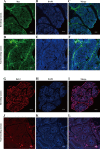Effect of muscone on anti-apoptotic ability of muskrat prostate primary cells
- PMID: 35968898
- PMCID: PMC9602688
- DOI: 10.1152/ajpregu.00068.2022
Effect of muscone on anti-apoptotic ability of muskrat prostate primary cells
Abstract
Muskrat is a small fur animal with a pair of scent glands that can secrete muskrat musk during breeding season. The consensus is muskrat musk functions as a pheromone, but we hypothesized it has a broader role. In previous research, we found the presence of muscone in muskrat musk. To study whether the muscone can affect the apoptosis of muskrat prostate, we carried out the following investigations. Primary muskrat prostate cells were cultured and treated with muscone. Then we drew cell proliferation curves by applying the CCK-8 and used TdT-mediated dUTP nick end labeling (TUNEL) to detect apoptosis. Levels of mRNA transcription and protein expression of Bcl-2 as well as Bax were detected by qRT-PCR and the Western blot. Meanwhile, we collected tissue samples of muskrat prostates and froze sections to analyze the fluorescence signal intensity of BCL-2 and BAX via immunofluorescence. Under the treatment of 30 μmol/L muscone, the proliferation rate of the experimental group exceeded that of the control group, and the proportion of cells undergoing apoptosis was lower in the experimental group. The qRT-PCR and Western blot result showed that, in the experimental group, the ratio of Bcl-2 to Bax mRNA transcription levels increased by 2.85 times and their corresponding protein expression ratio increased by 2.37 times (P < 0.05). Immunofluorescence results were consistent with the cell experiment's results. The fluorescence signal intensity of BCL-2 was higher in the breeding season than nonbreeding season but vice versa for BAX. Based on these results, we speculate that the muscone could regulates prostate development by inhibiting apoptosis.
Keywords: apoptosis; muscone; muskrat (Ondatra zibethicus); primary culture; prostate.
Conflict of interest statement
No conflicts of interest, financial or otherwise, are declared by the authors.
Figures







Similar articles
-
[Comparative analysis on the transcriptomes of the prostates of muskrats at breeding stage and non-breeding stage].Yi Chuan. 2018 Jun 20;40(6):488-495. doi: 10.16288/j.yczz.17-409. Yi Chuan. 2018. PMID: 29959121 Chinese.
-
Seasonal expression of androgen receptor in scented gland of muskrat (Ondatra zibethicus).Gen Comp Endocrinol. 2014 Aug 1;204:1-7. doi: 10.1016/j.ygcen.2014.04.031. Epub 2014 May 10. Gen Comp Endocrinol. 2014. PMID: 24818970
-
Protective effects of muscone on ischemia-reperfusion injury in cardiac myocytes.J Ethnopharmacol. 2011 Oct 31;138(1):34-9. doi: 10.1016/j.jep.2011.08.009. Epub 2011 Aug 11. J Ethnopharmacol. 2011. PMID: 21856397
-
Musk gland seasonal development and musk secretion are regulated by the testis in muskrat (Ondatra zibethicus).Biol Res. 2017 Mar 4;50(1):10. doi: 10.1186/s40659-017-0116-9. Biol Res. 2017. PMID: 28259185 Free PMC article.
-
Muscone alleviates neuronal injury via increasing stress granules formation and reducing apoptosis in acute ischemic stroke.Exp Neurol. 2024 Mar;373:114678. doi: 10.1016/j.expneurol.2024.114678. Epub 2024 Jan 5. Exp Neurol. 2024. PMID: 38185313
Cited by
-
An Investigation of the Saccharides Profile and Metabolic Gene Expression in Muskrat Scented Glands in Different Secretion Seasons.Animals (Basel). 2024 Dec 22;14(24):3705. doi: 10.3390/ani14243705. Animals (Basel). 2024. PMID: 39765609 Free PMC article.
-
Volatile Compounds in Musk and Their Anti-Stroke Mechanisms.Metabolites. 2025 Mar 7;15(3):181. doi: 10.3390/metabo15030181. Metabolites. 2025. PMID: 40137146 Free PMC article.
References
-
- Ahlers AA, Heske EJ. Empirical evidence for declines in Muskrat populations across the United States. J Wild Mgmt 81: 1408–1416, 2017. doi:10.1002/jwmg.21328. - DOI
-
- Greenhorn JE, Sadowski C, Holden J, Bowman J. Coastal wetlands connected to lake Ontario have reduced muskrat (Ondatra zibethicus) abundance. Wetlands 37: 339–349, 2017. doi:10.1007/s13157-016-0874-0. - DOI
-
- Roberts NM, Crimmins SM. Do trends in muskrat harvest indicate widespread population declines? Northeast Nat 17: 229–238, 2010. doi:10.1656/045.017.0206. - DOI
-
- Sun F, Zhang Z, Liang D, Yu H, Zheng X, Huang Y. GC-MS analysis of the differences in the chemical components of muskrat and musk. Nat Prod Res Dev 33: 1643–1648, 2021. doi:10.16333/j.1001-6880.2021.10.003. - DOI
-
- Chen Y, Jin S, Dong W, Tong Y, Hua S, Zhao H. Effect of muskrat on the cardiovascular system in anesthetized dogs. Chin J Chin Mater Med 14: 241–256, 1989. - PubMed
Publication types
MeSH terms
Substances
LinkOut - more resources
Full Text Sources
Research Materials

